Culinary Expedition to Kashmir
My visit here was driven by a desire to learn and understand the intricacies of Kashmiri cuisine and its influences. I wanted to find out how Kashmiri cuisine came to be what it is.
After a flight from Mumbai to Srinagar, Hashim picked me up at the airport. After a 20-minute drive, passing hundreds of uniformed military soldiers, we reached the Nedous Cottage. My first meal in Srinagar was the famed “Rogan Josh”.
Nedous cottage
The ‘Nedous’ had emigrated from Dubrovnik, a Croatian city on the Dalmatian coast of the Adriatic Sea, to Lahore in the 1800s, which was within her Majesty’s said Indian Territories.
My visit here was driven by a desire to learn and understand the intricacies of the cuisine and its influences. A few questions I had already were:
- Are chilies and its imparting colour of critical importance. Is it “ratanjot” alkanet, (a herb in the boragefamily and its main notability is its roots, which are used as a red dye. The plant is also known as dyers’ bugloss, orchanet, Spanish bugloss) that imparts flavour and colour or just colour?
- What does a saffron plant look like and what makes it the most expensive spice in the world?
- Why is salt added to their tea called “Noon Chai”
Famed local eatery – Adhoos – was a place repeatedly recommended to me. A 10km walk from my cottage, I had planned to spoil myself with all 36 dishes which make a “Wazwan”. The preparation of this multi-course meal in Kashmiri cuisine is considered an art and pride of Kashmiri culture. After seeing the generous portions and the steward’s advice, I revised my orders to choose only the specialities: “tabakhmaz”, “lahebi kebeb”, “gushtaba”, “haak saag”, “mirchi qurma” and steamed rice, for desserts; “phirni” and “kehwa tea”.
I loved the concept of “tabakhmaz”, shallow fried, boiled baby ribs with very subtle but aromatic spices of fennel, ginger and mint. The “lehbi kebab” was also impressively tender and I found out that traditionally the lamb is mashed with walnut wood. Similarly, I enjoyed the “gushtaba” for its satin-soft feel and bite, which paired particularly well with the light texture of the rich ghee, yogurt sauce. The “Haak saag”, a slight sour tasting dish of greens, was also great. On the other hand, I wasn’t as big of a fan of “mirchi qurma”, which for me was overpowered by the chillies. The “Firni” was quite runny, a contrast to the firmer and more set version I have eaten at other eateries. Whilst the originality is certainly debatable, I can confirm that I was happy with the taste. Finishing off the meal, I enjoyed the “kehwa”, a soothing tea consisting of saffron gently brewed with green cardamom, cinnamon and almond flakes. My return walk of 10km to the cottage was much needed.
On my next day, I had planned to experience Srinagar’s local streets and by-lanes. I woke up feeling fresh and am certain this was down to the saffron tea. My day started with a breakfast of “noon chai” (salty and dense brewed tea, very local to the hills here though not my first choice) and “girda” (Kashmiri roti). Possibly framed as the Indian cousin to the sourdough, the roti had a crisp exterior and soft interior.
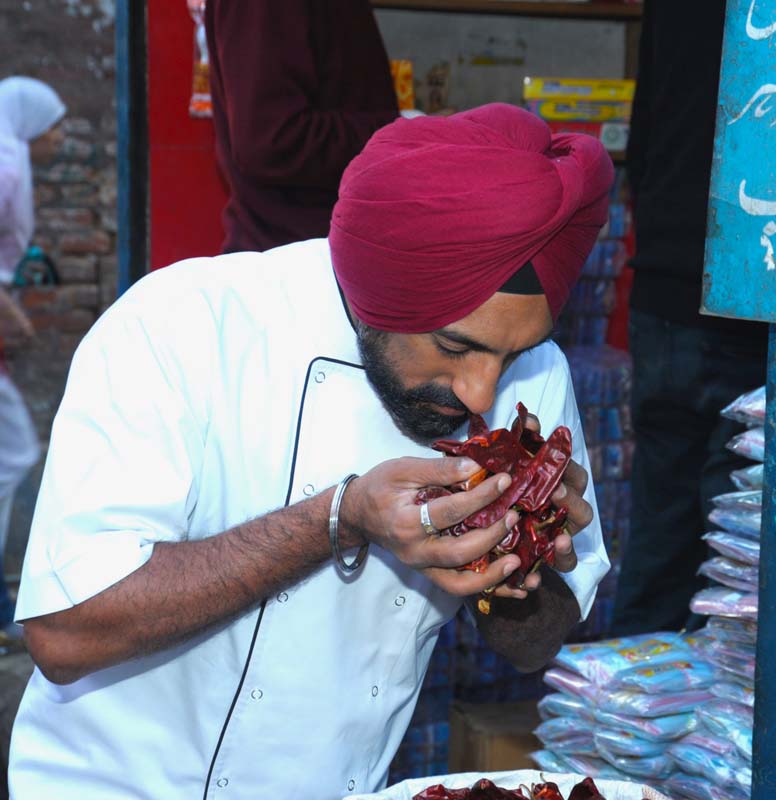
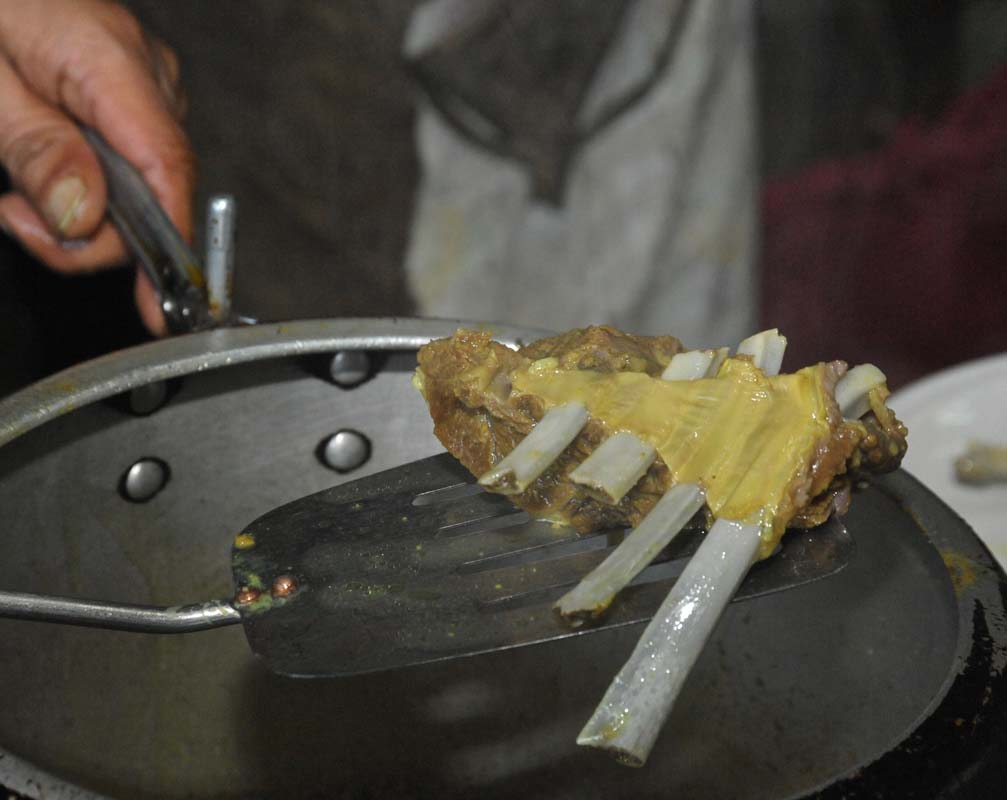
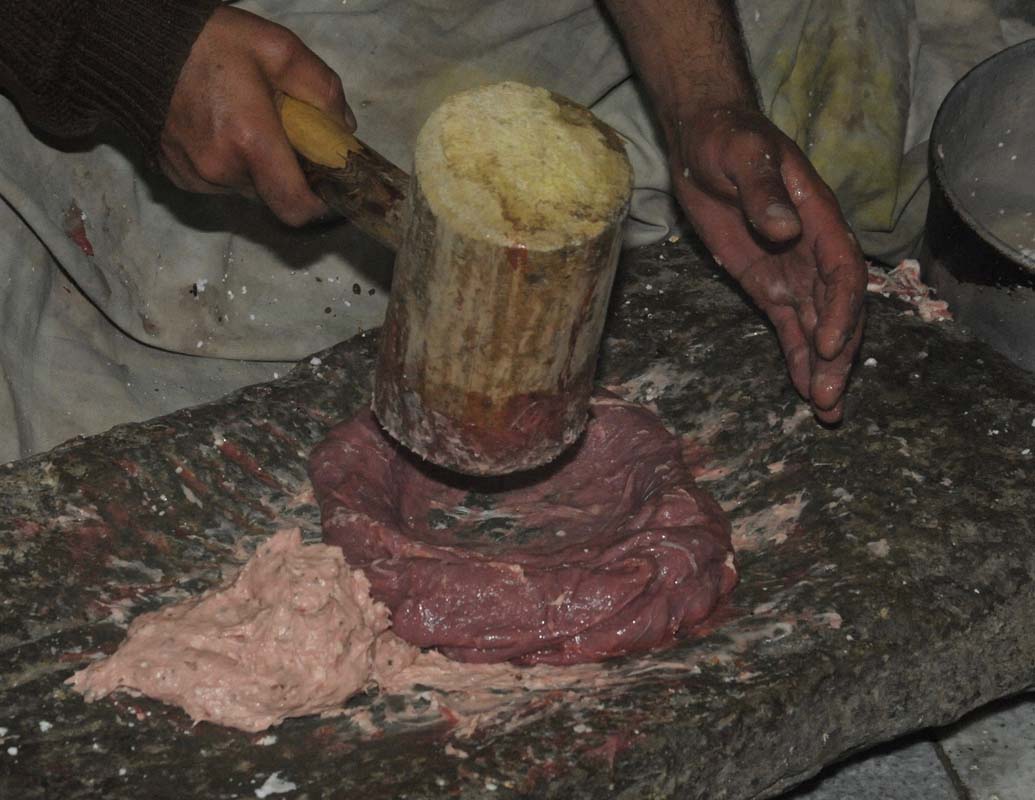
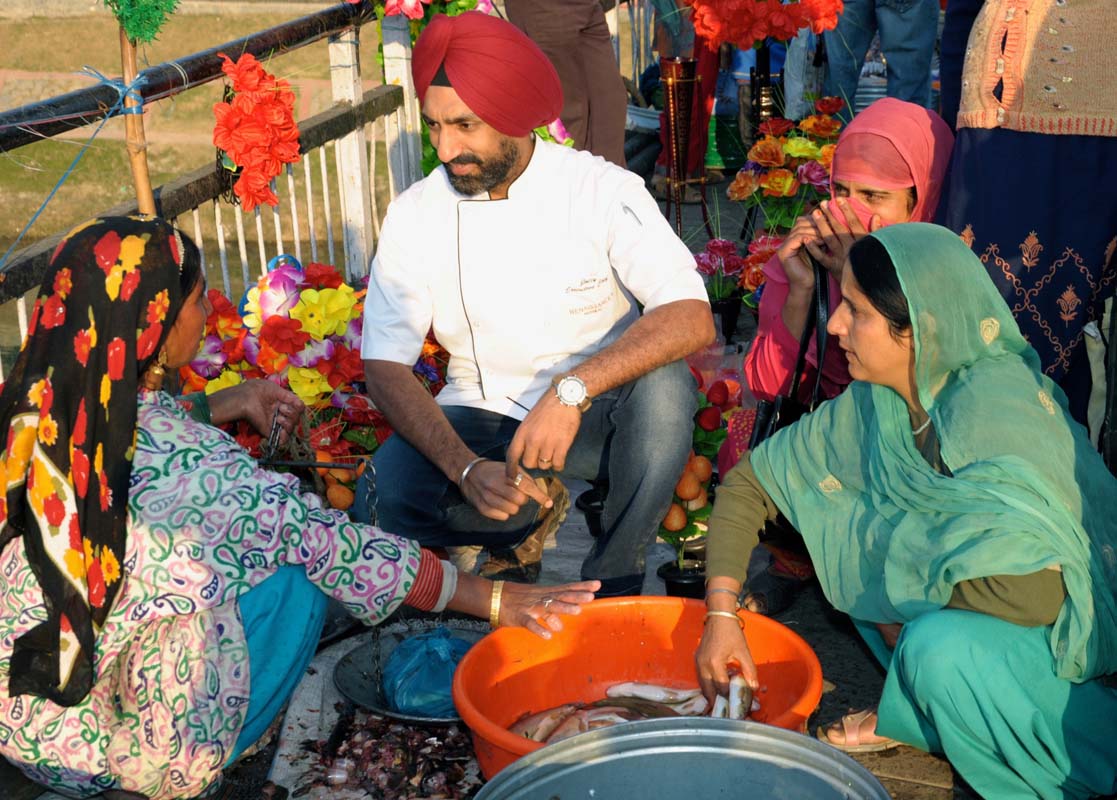
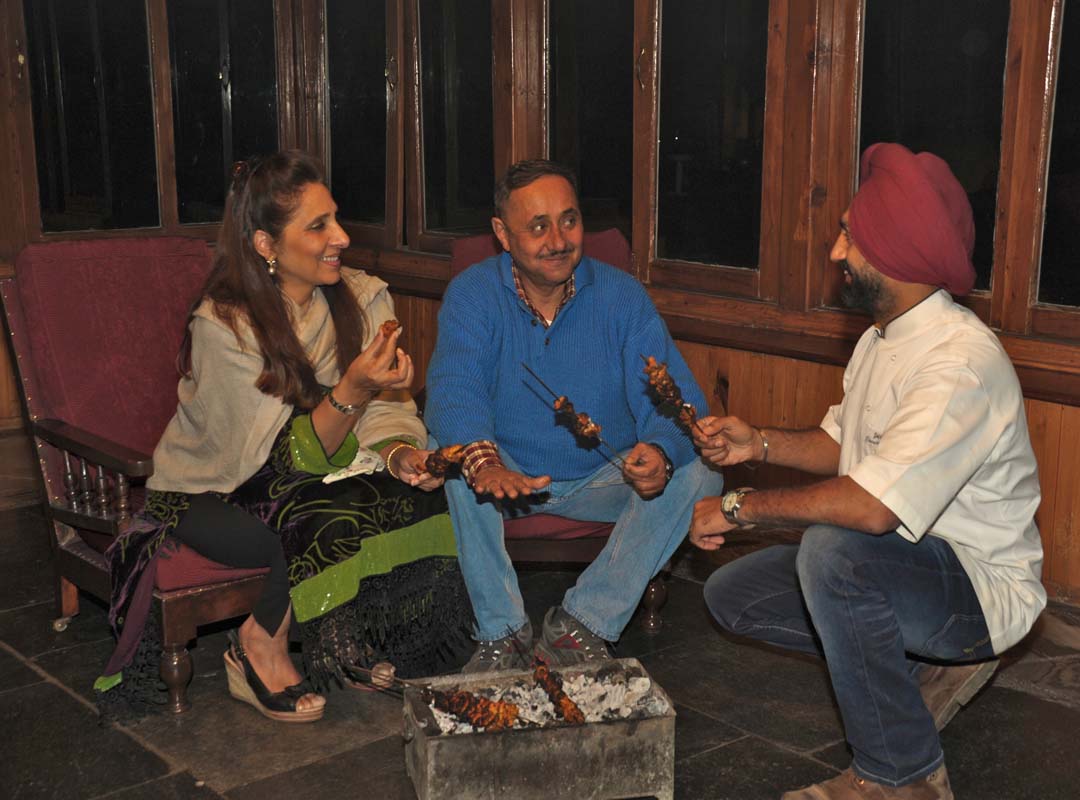
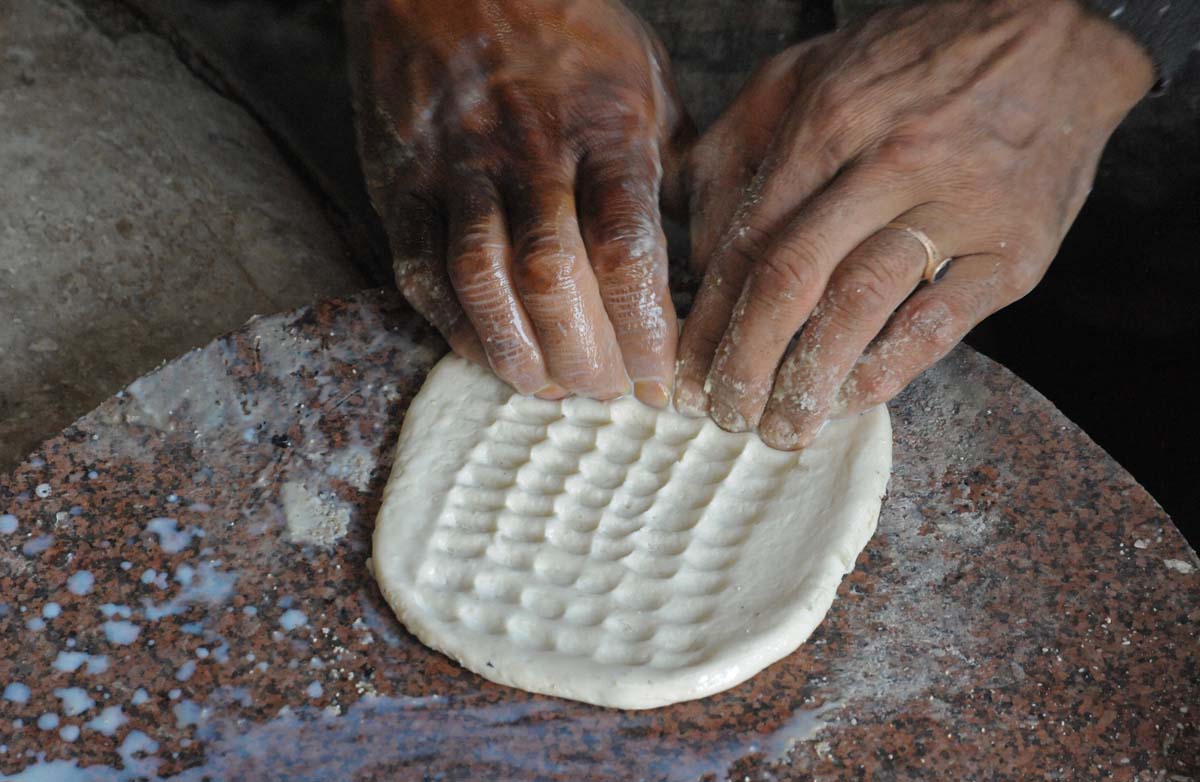
After breakfast I explored the inner city with Mr Amin, an experienced local elder. It’s always advisable to learn the culture, ways of life, traditions, weather conditions and history amongst other important influences, to understand the culinary legacy of the land. Together we visited Hazartbal Shrine, Nigeen lake, Jamia Masjid, Chatti Patsha Gurudwara, Hazarat Sultan fort, Dastgeer Saheb Khaneyar and Lal chownk. It would take me a whole book to take you through these very important places.
We also paid a visit to shops selling dried vegetables, namely ala hach (sun dried bottle gourd), vangun hach (sun dried eggplant) and ruangan hach (sun dried tomatoes). These dried vegetables are rehydrated and used in locally inspired curries and can also be considered a traveller’s best friend, given that they don’t spoil during long travels.
Besides visiting those shops, I also came across local shops selling “Taashnari”, a portable handwash basin, “Samovar”, a tea kettle heated with coal, “Traami”, a communal platter to eat from, and “wazwan sarposh”, a cloche for Trami.
Kebabs to be sampled tomorrow will be “Tujee kebeb”, meat slices skewered on to a metal skewer to be grilled on a charcoal grill. We also passed by many stalls selling fried “nadru” chips, lotus stem fries, “singara” and “watana”.
Mrs Daisy Nedous
Later I met with the lady of the house, Mrs Daisy Nedous. The insight that she shared with me can only be gained from homes who have lived the glorious past.
A Kashmiri’s day wouldn’t be complete without a cup of piping hot nun Chai (Salty pink tea) and a crisp, freshly baked bread from the Kandur (the traditional bakery). While the entire valley is still shrouded in darkness, the Kandur remains awake preparing his tandoor to bake breads for the morning breakfast. The Kandur forms an intrinsic part of the social life in Kashmir and every locality has their own local Kandur, from which the people purchase their daily quota of breads. In Kashmir, the Kandur shop isn’t just a place where one goes to buy the morning and evening breads, it is a social hub. A place where you get to hear and participate in discussions that range from gossip to political discourses to moral lectures. It is the place where all the local happenings are discussed. The discussions that take place in a Kandur shop or Kandur waan, as it is called in Kashmiri, are as varied and unique as the breads that are baked in the Kandur’s oven.
For all the breads, aroma, smell, appearance, colour, size, and overall texture are characteristics optimized by the kandurs after many years spent mastering this art. The texture and quality of these breads are determined by the percentage of wheat protein, temperature and type of flour present in the bread. There are about 14 different varieties of breads you must try when in Kashmir. Additionally, plain cake & coconut cookies with tea is every Kashmiri’s tea time favourite.
Harrisa (made with meat and oat porridge) signals the oncoming of winter and is enjoyed for an early morning breakfast. Usually, only men would go and sit socializing and eating called Hamam (unlike Turkish hamams baths).
The floating vegetable market at the Dal lake
The next day’s plan was something I had longed for years. We went to explore the floating vegetable market at the Dal lake in the early hours, which was followed by a visit to Pampore to experiencing saffron harvest and picking and then a drive to Gulmarg to cook with the “waza” (the chief cook) Gulam Nabi.
The “shikara”, the houseboat driver, rode me through some of the local boat vendors selling fresh produce. It was indeed the floating market I had heard of. I was pleased to see the local Kashmiri “saag” greens growing in full blossom, the Kadam haak, turnips, lotus root and also water lilies amongst others.
Hashim drove me to the highly sought-after saffron plantations, India’s famed saffron fields, which is a little ahead of Pampore (outskirts of Srinagar). Mesmerised by the vast acres of land all being used to cultivate saffron, I couldn’t wait for my first contact with saffron growing in the fields. It was a much-awaited visit, as I have been planning it for a little over 10 years, and since I launched my most successful restaurant called Saffron at the JW Marriott Hotel in Mumbai, India. I knew, I’d cherish this for a lifetime.
Gulmarg
Later, we left for Gulmarg and visited the Nedous Hotel. The Nedous family were the first to ever run a hotel here, and possibly even in India, with the hotel dating back to 1880. I was told that they hailed from Yugoslavia and have continued to preserve the history and heritage. I loved the feel and vibe of this place so much that I decided to stay overnight. During my stay I was told about the legendary cook Gulam Nabi, who has been cooking here for over 30 odd years now. Fascinated by his commitment, I was eager to dive in with many questions, whilst anxiously waiting for an opportunity to cook with him.
Gulmarg is also one of the most popular tourist spots in India. Undeniably picturesque but for me, it was still largely about learning about the food, the culture and the stories behind traditions. I was keen to learn more about the traditional “wazwan” delectable spread, which are served on the Trami and generally portioned for 4 people. Sharing the platter is considered respectful.
The waza narrated the traditional ways of cooking and we started straight away without losing any time. The food is served in courses as follows:
- Gosht seekh Kebab/tabakh maaz (ribcage braised and pan fried under pressure)
- Lahbi kebab – meat mashed to the texture of gostaba but shaped flatter and with a sauce like Hindi-style rogan josh (a bit of yogurt in rogan josh makes it Hindi rogan josh)
- A dry chicken which is either roasted or shallow fried
- Methi maaz – minced lamb intestines or also lamb stomach cooked with “methi” and fresh fenugreek, served alongside steamed rice or a Kashmiri Pulao (rice cooked in stock with small pieces of lamb and dry fruits and nuts, typically almonds, walnuts, raisins and pistachios. All these are served on a Trami.
Later the waza serves on the trami the following dishes in order:
Rista (koftas or lamb meatballs in a spiced curry), Rogan josh, Mirch korma, Aab gosht (lamb cooked in milk), Alubhukara maaz (lamb cooked with plums), Waza tsaman (paneer), Palak Kofta, Waza Saag, local kadam or haak greens stirred.
Lastly, there is goshtaba, the lamb kofta dish considered the “king of Kashmiri dishes” and the pashmina of meats. The reason for the naming is that the meat is traditionally mashed continuously with a Chinar mallet and walnut wood bark to achieve an incredibly smooth paste. Later, it is shaped into balls and poached in stock, before being finished off in a mildly spiced yogurt stew. The flavours in here are subtly enhanced using ground black cardamon, dried fennel, mint powder and a tiny bit of black peppercorns. It’s as simple as it can get but just divine in taste and best had with boiled rice.
Wazwan is most often eaten with rice, no bread. Kashmiri breads are plentiful but are associated with breakfast and teatime, not main meals. The best quality rice and that is locally preferred are Muskh Badiz, Vogmil baz and Chinibar. The village I am told for the rice is Margam, which is just by the Srinagar outskirts.
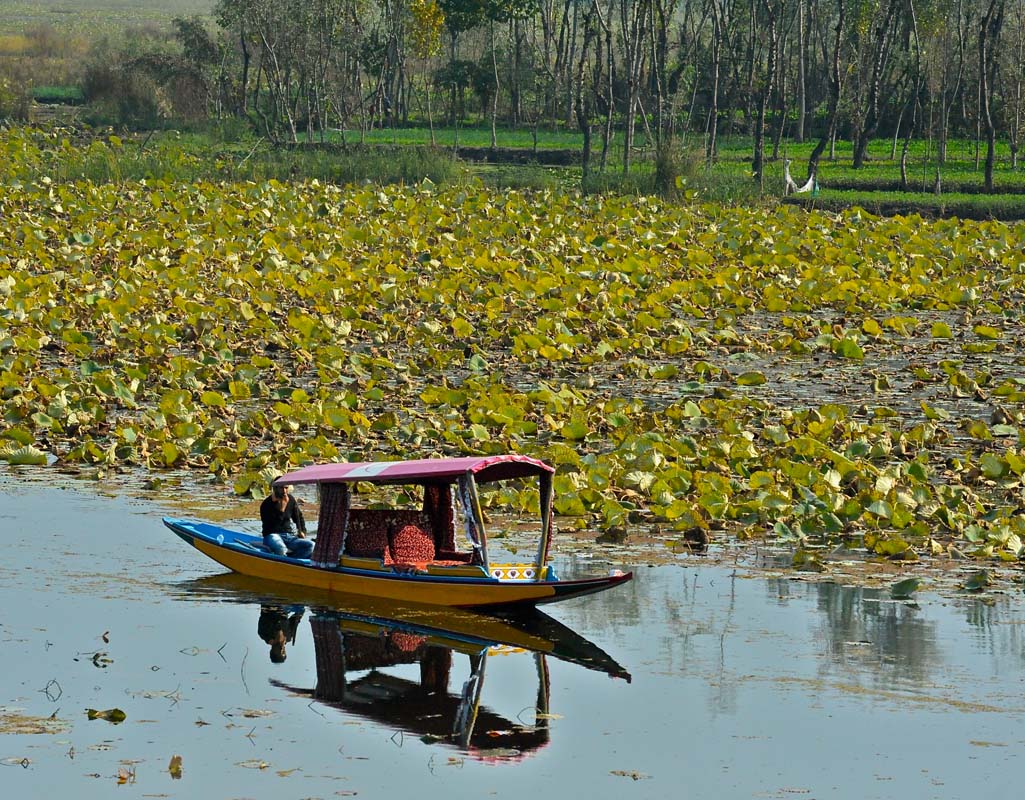
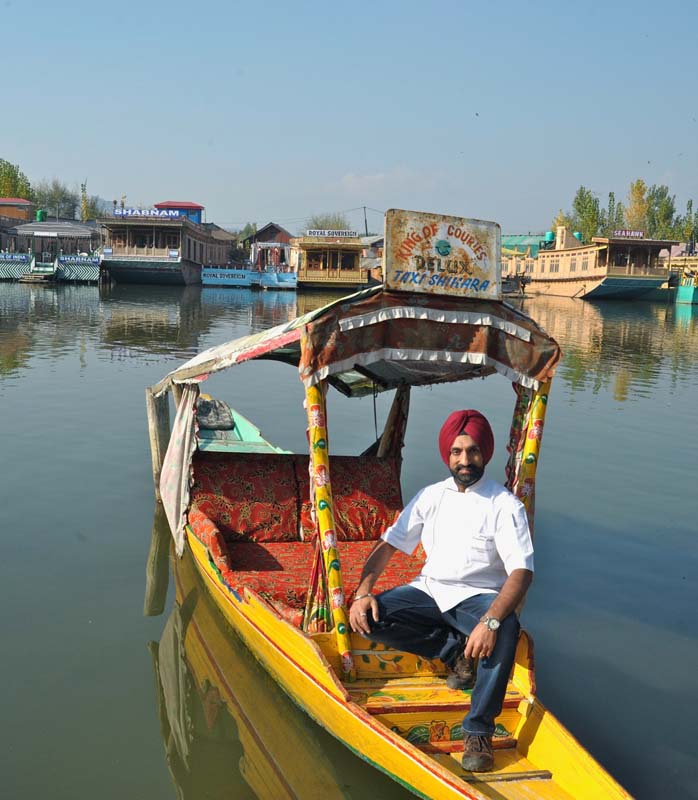
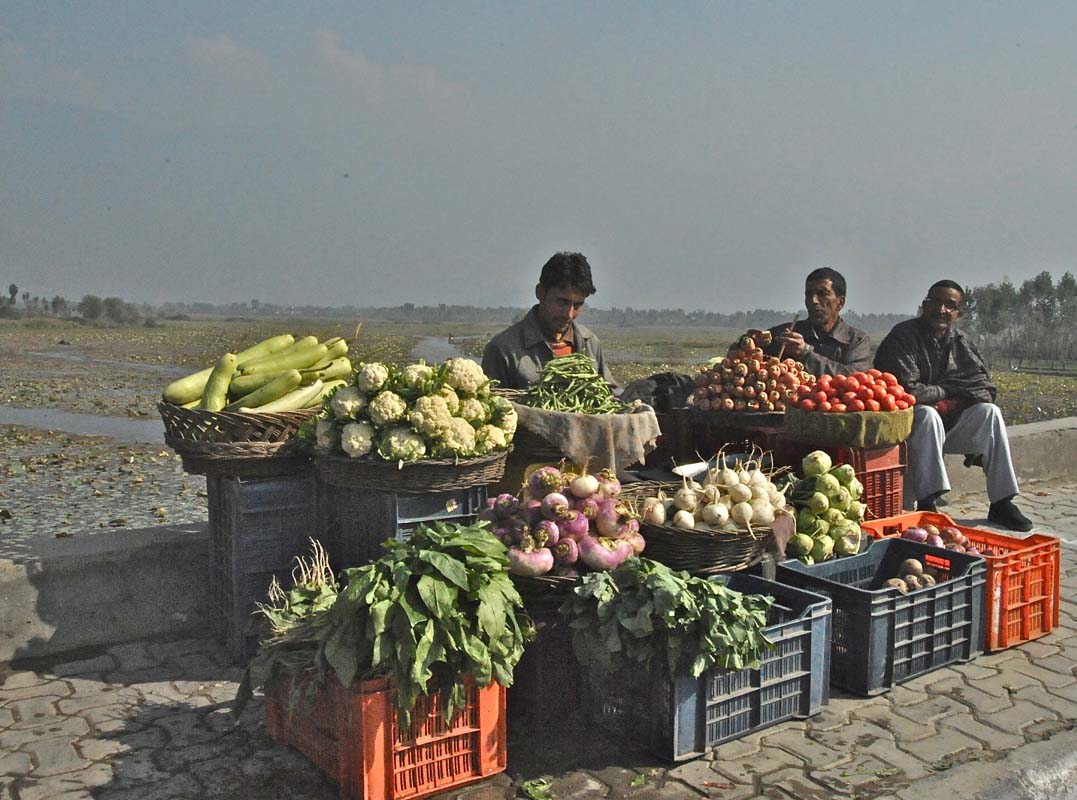
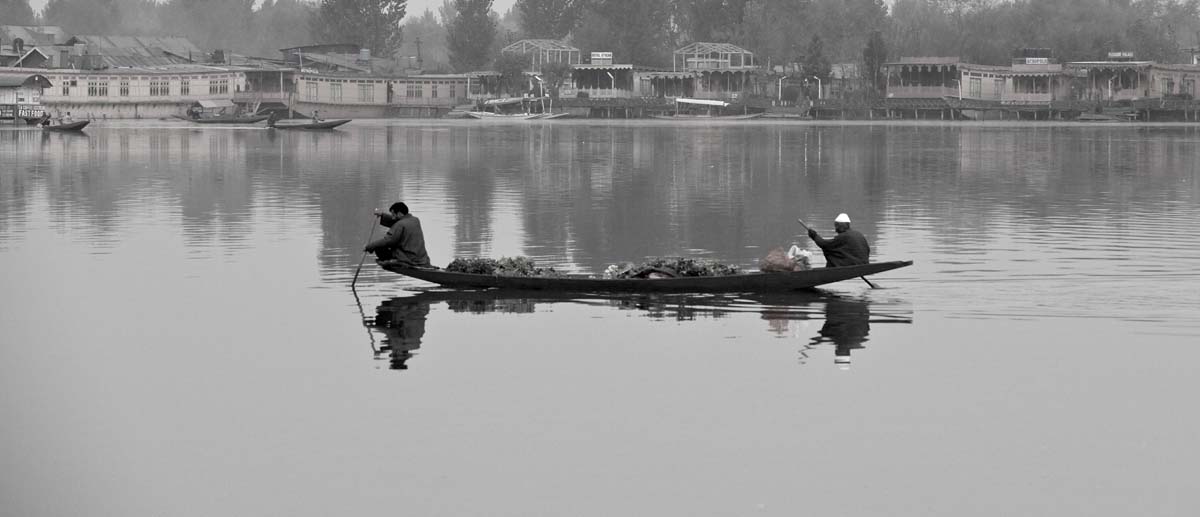
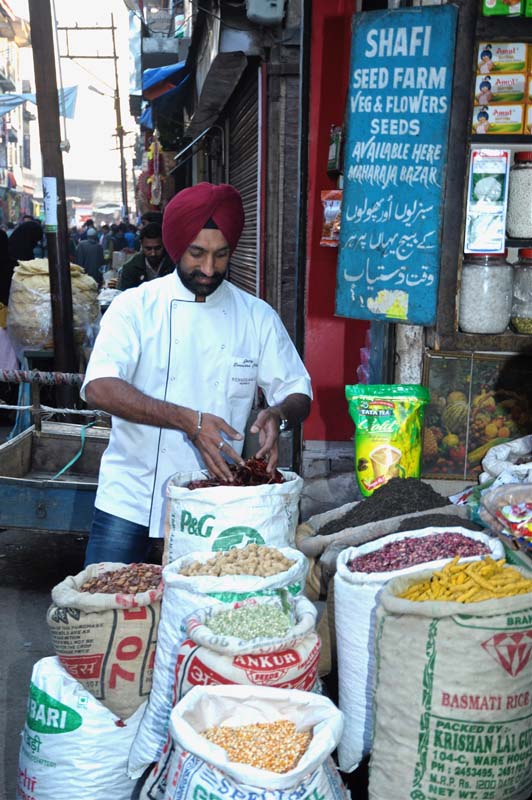
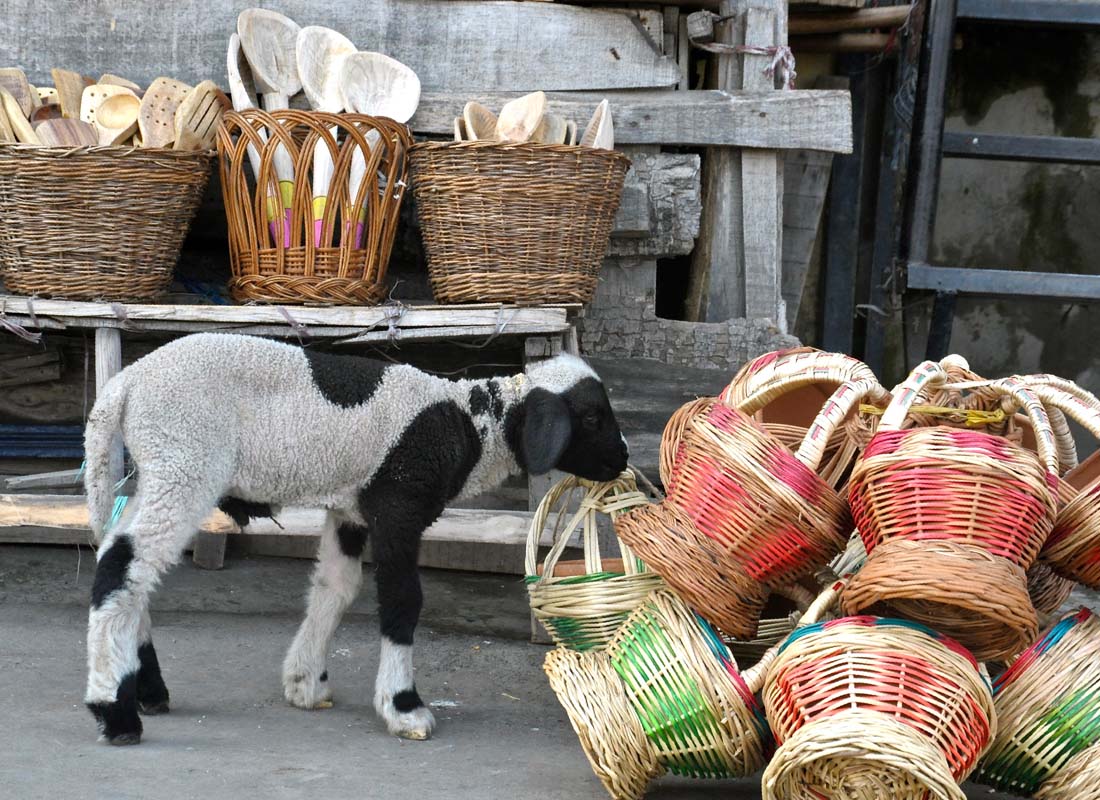
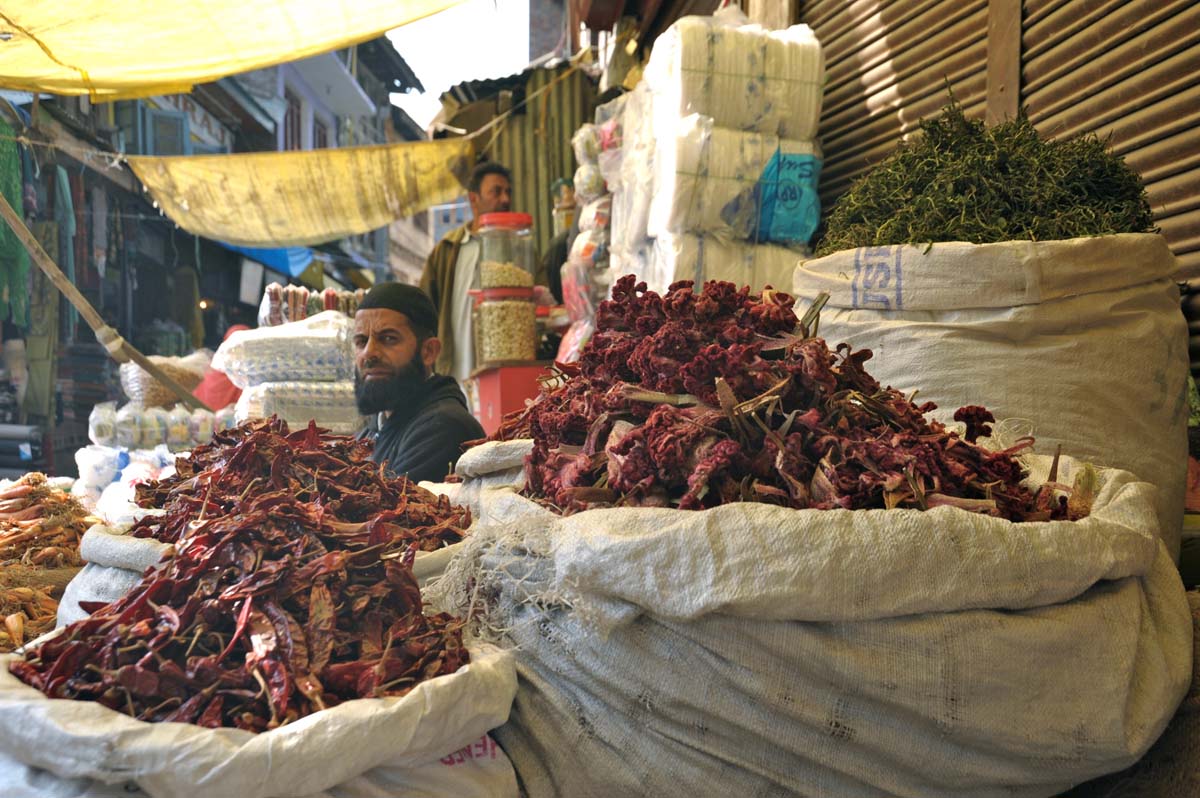
Discussing further with Waza Gulam Nabi on Pundit’s Wazawan or Hindu style of preferences some of them are Nadru (lotus stem), Dum Alu (potatoes in yoghurt), Saag Tsaman (paneer with local greens), Rajma (stewed kidney beans with “gogji” or turnips), local river fish with Nadru, lotus stem or Muj, round local radish and fried fish. In relation to the Muslim Wazwan, Hindu pundits are less elaborate.
A few home style cooking dishes are:
- Rajma Gogji, kidney bean stew with turnips.
- Saag, stirred local greens
- Nadru Palak, Local greens with lotus stem
- Methi Nadru, Lotus stem with fresh fenugreek
- Rehydrated sun-dried bottle gourd, tomatoes and eggplant in a light yogurt-based stew or a thin curry
We then broke for lunch and were served some of the best dishes I’ve had with rice and grilled whole wheat bread. The first was “Chokha vagun”, a sour eggplant with tamarind pulp, paste of praan (local banana shallots like onion which are fried and ground into a paste), garlic, ginger, red chili paste, green cardamom, turmeric, fennel, a bit of garam masala and bay leaf. Second was the Gosht Rogan Josh, a lamb curry with “mawal”, a local summer flower which is a red colouring agent. This is a very indigenous ingredient only practiced in Kashmiri cuisine. We also enjoyed Phirni, a rice & semolina pudding with dried fruits and poppy seeds used as a garnish. Whilst it can be had both warm and chilled, I prefer the latter.
During these lunch talks, I learnt that walnut oil used to be a medium of cooking many years ago and imparted a sweeter & nuttier flavour to dishes, compared to cooking in mustard oil. I also found out that lamb has always been preferred over goat meat and considered more prime and royal, and that the meat preparation of both Rista and Gustaba are the same. The slaughtered meat is beaten on stone blocks, or in some cases walnut wood barks, with hammers made of chinar wood until they become soft and paste-like. To incorporate air to make them light and fluffy, the meat undergoes a process of being folded whilst beaten. Typically, at this stage, the spices that are added are black and green cardamom and caraway.
How do we distinguish Rista and Gustaba visually? By the colour of the sauce. Rista is primarily red due to the red chilli, whilst Gustaba is whiter. Both the sauces are fine, and I would like to believe that the Persian influences here have made it such. The ingredients for the Gustaba sauce include yogurt, that is whisked with water to break its protein bonds before they are boiled in a degh (large, round-bottom vessel made of copper) to avoid splitting or food poisoning, ghee and an assortment of ground spices (cinnamon, black and green cardamom, fennel, dried ginger and coriander powder). Rista, on the other hand, uses a cooked paste of praan, garlic, red onion and the extract of red dried chili.
For a perfect Aab Gosh, meat is traditionally cooked with milk, or Aab as Kashmiri’s call it. Here I am told that they reduce fresh milk with cinnamon, green cardamom, paste of praan, garlic, ginger powder and fennel powder and the tender boiled meat is simmered in the milk sauce until the flavour becomes well-rounded. Similarly, rather than using milk, “Yakhni” uses yoghurt and sometimes dried mint leaf powder, especially when cooked with bottle gourd/lauki.
Other dishes made here include “Doon”, a walnut chutney particularly important in Wazwan made from milk-soaked walnuts, mint leaf, yogurt, green chilis and salt, Onion Chutney, prepared with yoghurt, green chilis and mint, Dum Alu, fried potatoes gently cooked in a yogurt sauce made with praan, garlic, bay, green cardamom, cloves, dried ginger and dried fennel seeds, and Corn bread (makai roti). Walnuts are abundant here and are frequently featured as part of the dessert menu, unlike in London.
Cook-off with Waza Gulam Nabi at Gulmarg followed by a tet-e-tet with Waza Bakshi
On the day of the cook-off, I began preparations including beating the freshly slaughtered sheep meat on a stone with a mallet made from the popular Chinar wood, also called “Gosht Phari” in Kashmiri dialect. I noted down the information I gathered to prepare the Goshtaba and would like to share them with you. Firstly, using a malate and a stone, mash the freshly slaughtered lamb with kidney fat, black cardamom, black pepper and salt until the texture becomes a smooth paste. Once you reach this stage, remove all the sinews possible and shape into balls of roughly 60grams each. Poach them in lamb stock (flavoured with cinnamon & black cardamom) and simmer. Simultaneously, prepare the sauce by beating yoghurt with a bit of water till smooth. In a heavy-bottom pan, boil the beaten yoghurt on moderate heat, stirring it with a whisk till it boils and then reducing to a simmer. Add to the boiling yoghurt cinnamon, green and black cardamom seeds and ghee, cooking till the ghee separates and floats on top. Then, add your lightly fluffed up meatballs into the sauce and simmer for another 15-20 minutes (add stock as necessary based on the texture of the sauce). The meatballs will become fluffier and the sauce will reduce, and the flavours intensify.
For Rogan Josh, the lamb cut is taken from the shoulder, saddle and ribs but for the Rista, minced meat balls are used in the sauce. Another key difference between the two is that mawal extract is added only in the Rogan Josh. The process for both begins the same. Blanch the lamb in stock and wash the scum off it. In a clean pot with fresh clear stock start boiling the lamb meatballs or the lamb meat with bones. Add to it the whole spices, fried praan paste, chili extract and ghee. Once the lamb is tender, add ground spices, fennel, ginger, green cardamom and cinnamon. Separate the sauce in two bowls and to the one for Rogan Josh add mawal flower stock. For both, pour hot ghee or mustard oil on top and garnish with fried praan paste & saffron extract (optional). Another dish similar to Rogan Josh is the Alubukhara maaz, with the latter differing in its slightly sour taste, due to the unripe alubhukhara’s (plums). Some stuff the lamb kofta with it, whilst others enjoy it as wedges (deseeded & pan fried) in the dish. Additionally, the tamarind extract in Marchwagan Khorma is the only ingredient which differs from Rogan Josh, providing a sharpness due to the chili extract, and the lamb is pot roasted.
To prepare Seekh Kebab:
On a chinar wooden block, using a chopper, hand mince the meat (boneless leg and shoulder of the lamb) till it is finely minced. To it, add coriander leaves including its stem, royal cumin seeds, dried chili powder, black cardamom seeds, garam masala, whole raw eggs and salt. Mix and let rest for around an hour. In a preheated tandoor, roast the skewered lamb mince (using the egg wash as moisture to skewer it) till it’s well roasted and moves freely on the skewer when you try to swirl it (a sign it is cooked). Slide the meat off the skewer onto a chopping board, or straight onto a serving plate, and serve it hot. Alternatively, for larger events, in a large flat pan heat together ghee (or clarified butter), powdered Kashmiri spices and fried onion and gently pan fry to warm before serving.
To prepare Tabakh Maaz
Boil the ribcage in stock with turmeric, fennel seeds, cardamom, cinnamon and salt for around 2 hrs, or until the meat is very tender. Strain and reserve the stock for alternate use in any other sauce/rice prep. Cut the ribs in portion sizes and shallow fry the boiled ribcage bone side down, using a weight on top to press it whist frying, till golden brown. Flip and resume with frying on the other side, though this time without weight. The fattier side should become crisp, whilst the meat remains tender. Best served hot.
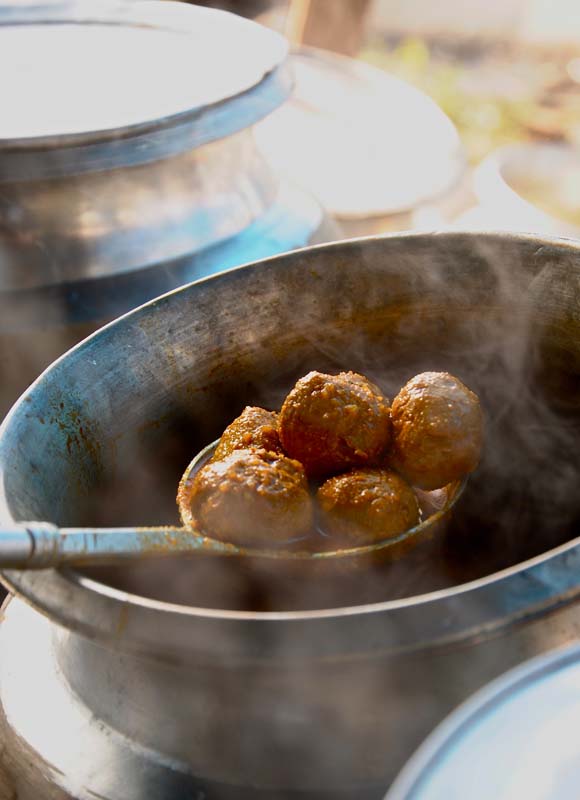
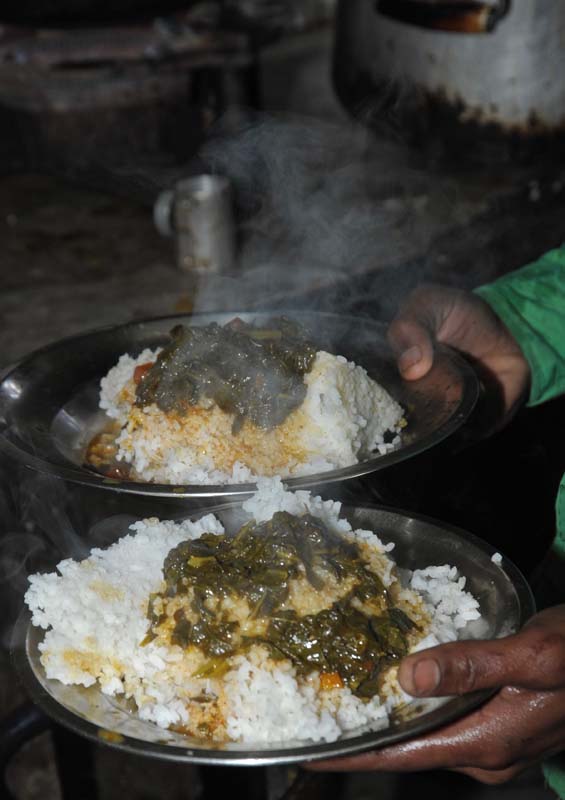
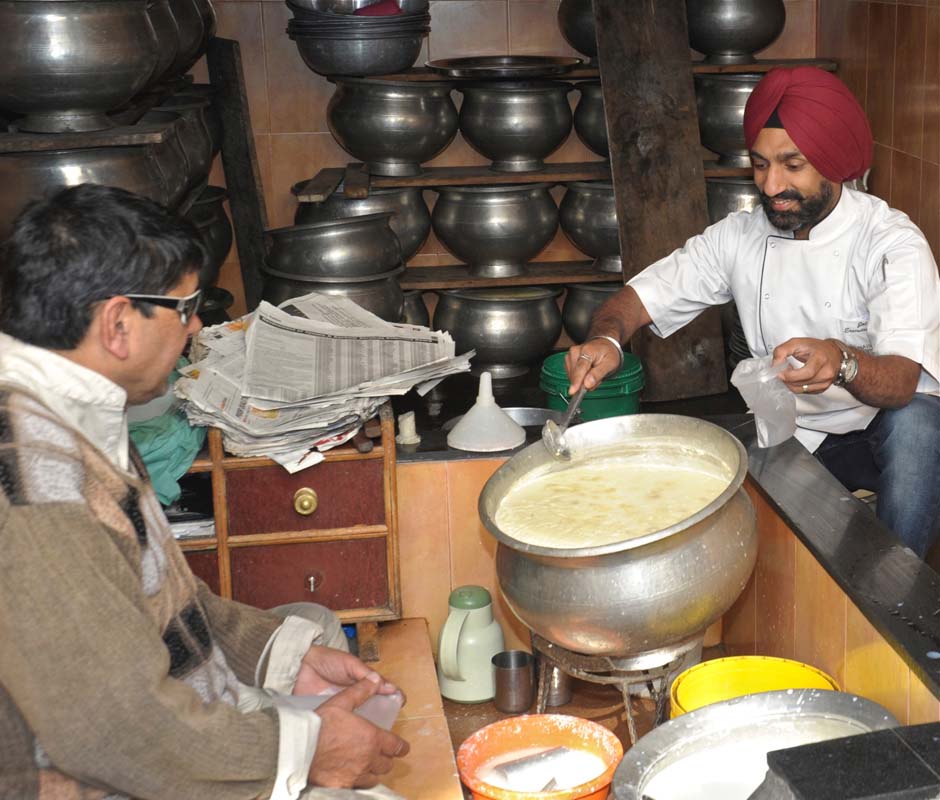
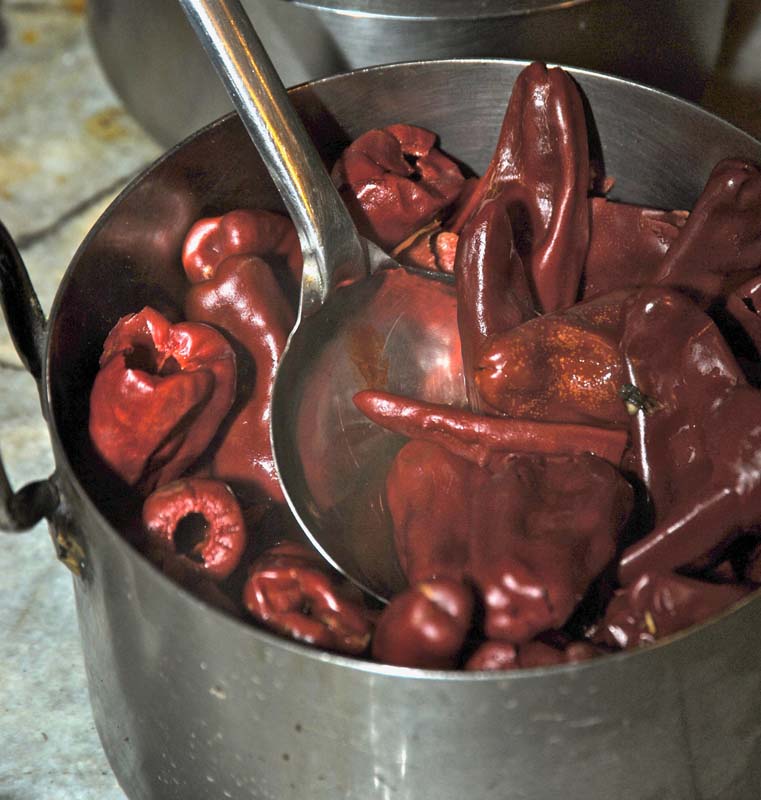
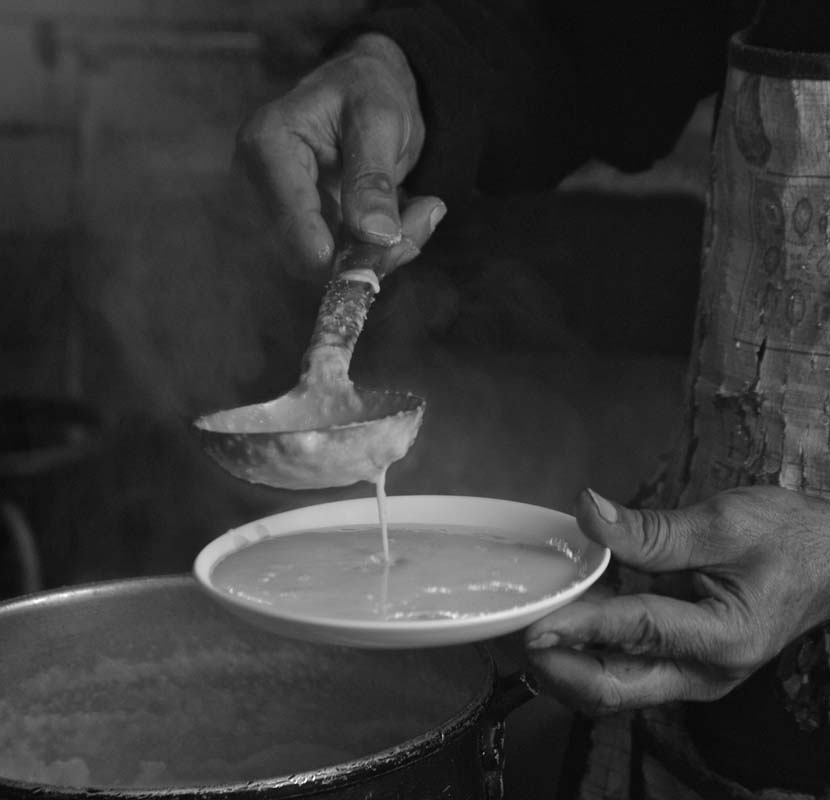
Following a catch-up with Waza Bakshi, lovingly called “Amma Kaka”, I was able to gain more insight into the ingredients used in dishes and variations. For example, I learnt that the quince apple, locally called “bamsooth”, is sometimes served for a Wazwan as a side dish or accompanying the meats. The quince apple is peel, deseeded and chopped into wedges and then they process to shallow fry and braise them in a sauce similar to that of Rogan Josh. Most dishes are red in colour, except for the likes of yakhani, goshtaba, dhaniwal khorma, hindi rogan josh (orangish) and many are finished with fried praan paste (for taste) and a pouring of hot of oil on the top. Relevant dishes are also further enhanced in colour by saffron extract (Rogan Josh, Rista) or Mawal. In terms of the greens I encountered, I found out that Knol-khol is called Kadam, and its greens are the saag which Kashmiri’s refer to as Kadam saag. For haak, these local greens are traditionally made with garlic, red whole chilies and garam masala. The texture is more like cooking spinach, but they have a profound taste. It is best enjoyed fresh and the locals would recommend spicing it up with red chili extract. Most Wazwan food is made with caramelised onion in smoked mustard oil. Traditionally, walnut oil was used, however cheaper alternatives have found a way in the kitchens. Another decreasing trend is the previously widely used earthenware and wood fire cooking methods, which now are only prevalent in interior villages of the terrain. Likewise, is the traditional lentil preparation here in Srinagar called Dal dabbi, using green moong lentils. After soaking overnight, sometimes for 2 days, and rubbed and washed well to remove the skin, it is cooked in milk with spices. The process is said to be tedious and now more or less forgotten.
Interestingly, trout is the most commonly consumed fish along with the fish from Dal lake. Fish is locally referred to as “Gard” and is traditionally cooked with 3 vegetables: muj/ radish, haak/Kashmiri saag and nadru/lotus stem. One popular example is Gard te’ Muj, i.e fish with radish. Other interesting information I would like to impart is that chicken dishes are mostly the drier version in the Trami, but also made well with fenugreek and spinach and that Kashtwar has best “Guchchi” morels, also called “Kuch” locally.
Did you know that “Tumul” is the local rice used for Wazawan (sometimes made with red rice)? When cooked, its appearance is similar to sella rice. Wazwan may also feature the Kashmiri pulao too. It is prepared by first dry roasting the rice with abundant ghee and later add stock or boiling water (generally 2:1, water to rice ratio) with brown praan paste, cinnamon and green cardamom.
Cook-off with Waza Bakshi
I shopped for local vegetables, meat, fish from Dal lake, spices, rice and then made my way back to the Nedous kitchen to cook straight away. The mise-en-place involved smoking the mustard oil, known as “durust” or getting it ready to use after cooling off. The lamb was cut to dish appropriate sizes and boiled with fennel seeds, black cardamom pods, cinnamon bark, cloves and salt. I made the stock and prepared the praan (peeled, chopped fried), with some to be used as is, and the rest to be made into a fine paste with a bit of water. I also prepared a dried simla red chili extract, by deseeding, boiling and straining the mixture. The fish was cleaned of the guts, gills and head, marinated with turmeric and salt and pan-fried.
Afterwards, I moved on to preparing the vegetables. Following a thorough cleaning, they were cut to respective sizes and shapes. Meanwhile, I had dried plums soaking in warm water, saffron stigmas soaked in a bit of water to get the extract, spices freshly ground to make a home ground garam masala (fennel, cardamom, cinnamon, dried ginger). Utensils were cleaned, knives sharpened on stone and Noon Chai (salted brewed tea) was made for all to drink. We sipped and got cracking. A few signature dishes were being prepared with Waza Bakhshi for my farewell dinner…
Alubhukara Khorma, Lamb and sour plum curry:
In a heavy bottom copper pot with hot mustard oil I added dried Simla chili powder, soaked “alu-bhukara”, plums, turmeric powder, fennel powder, garam masala powder, spices with saffron, boiled meat in stock, green cardamom powder and caraway seeds. It was left to simmer until the meat became tender, the sauce reduced, and it had matured with flavour. Praan paste was added and after brewing for a few more minutes, it was ready to be served.
Gard tey muj, khaneyari haak, nadru, Fish with radish, lotus stem and local greens:
In a heavy bottom copper pan, fry chopped praan in hot mustard oil till golden brown. Add turmeric powder, Kashmiri chili powder, salt, fennel powder, coriander powder and Simla chili extract for the red hue. Make a bed of vegetables (lotus stem sliced, haak greens and radish slices) and layer it well. Top with fried fish, mustard oil, shahi zeera and season it, keeping it sealed to steam. After 20-25 minutes, take it off the flame and let it cool. This dish is served at room temperature. I am told it is best had the following day when it matures with all ingredients and intensifies in flavours too.
It was Bakar-eid the following day and post attending their ceremonies, I left for the airport to get back to Mumbai. I had been looking forward to this experience on Kashmiri Wazwan cooking for so many years and it was as insightful and fulfilling as I had hoped.
Trivia
Noon Chai: Why was the tea salty? Why not use honey or sugar? Scientifically, I believe there are two reasons, both relating the body. Firstly, moisture retention, which is needed as the body gets dry rather quickly at this altitude and, secondly, it salivates the palate more. I also think that one craves for more carbs to help function the body better at this altitude. An interesting learning was that at higher altitudes, Yak milk is also used in a few food preparations.
Trami: is a traditional platter for “wazawan”, and is covered with “sarposh”, a copper cover.
Koftas: Made round by Kashmiri Muslims and oval/oblong by the Kashmiri Hindu pundits.
Haak Saag: More pot roasted, buttery and green when made by Muslims and less heavy by the Kashmiri pundits, baat-haak.
Tabakhmaz, a lamb rib preparation to Muslims is Kabargah to Hindu pundits (only Brahmins of Kashmir eat meat). Also, pundits boil the ribs in milk, whereas stock is preferred by Muslims.
“Kandoor”: Base for the origin of word Tandoor. Kandoor women tribe work to make breads whereas the Goor women work with cattle & milk
Wazawan: Sequential service of a variety of dishes on a “Trami”, a large serving dish.
“Tabakhmaz”: Begin by boiling lamb ribs in stock and then pan frying slowly, with a weight on it to flatten it, to make it crispy on the outside but soft inside. A pinch of turmeric, fennel, ginger and mint may also be added.
“Goshtaba”: A kofta in a yogurt stew with very fine-textured mincemeat. The meat needs to be light and aerated, achieved by folding the minced meat endlessly and with continued hand mashing on walnut wood (it’s of a fine frankfurter sausage meat texture). The yogurt sauce for the Gushtaba is very thin and flavoured by the ghee and mild spices, such as black pepper, ginger powder, mint and fennel powder.
“Ver”: A dried or moist paste made from praan paste fried in mustard oil, garlic paste, dried Kashmiri deseeded red chili paste and a handful of powdered spices including saffron, caraway seeds, cloves, green cardamom, cinnamon and black cardamom seeds. All are folded together and packed, or tied in a muslin cloth, and left to dry in the shade. Once dried, it is then stored in an air-tight container, or alternatively, bottled in a paste form. It is typically used as a dish finisher and dried sardines with dried chilies and seasonings are served as a side dip/chutney.
Dodhal: “Dodh” meaning milk and “al” meaning gourd. One quick preparation is peeling and deseeding the pumpkin, tempering it with crushed raw garlic, “shahi zeera” and caraway seeds and then adding beaten hung curd and salt and steaming it.
Radish chutney: A popular accompaniment with Tujee kebab (slices of marinated meat skewered and grilled) and sold along with lavaash bread.
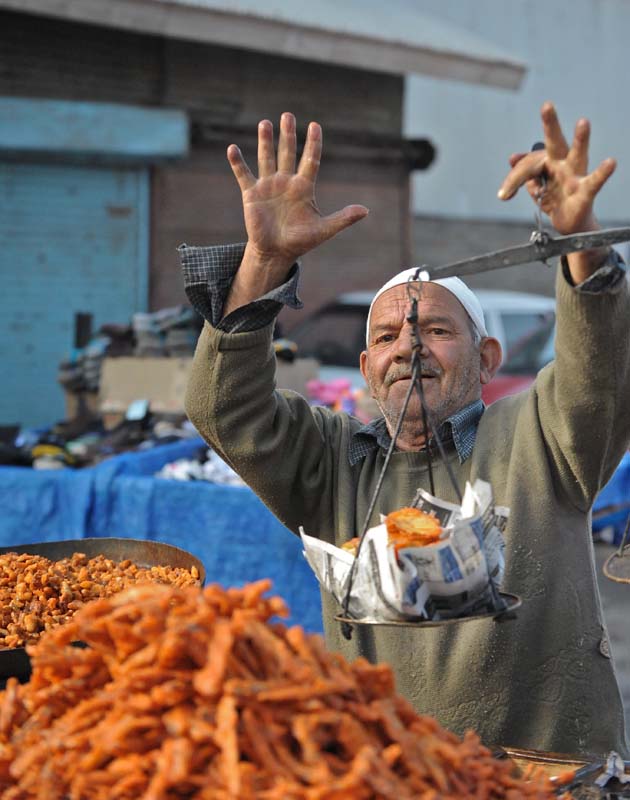

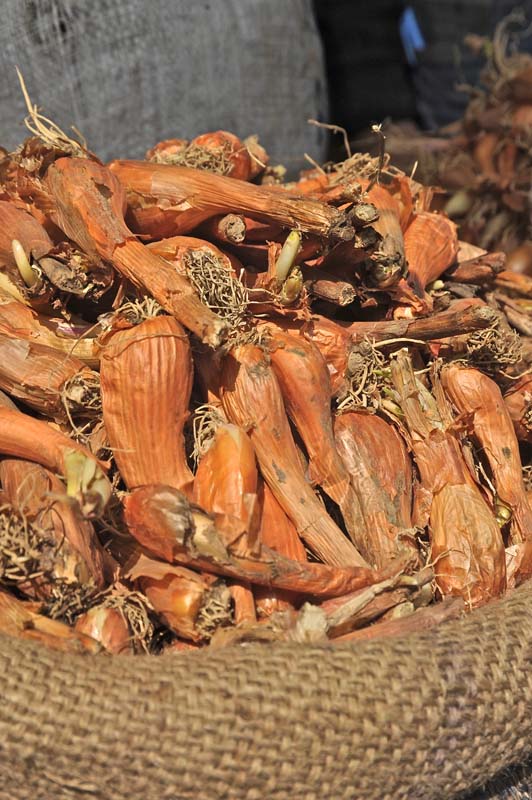
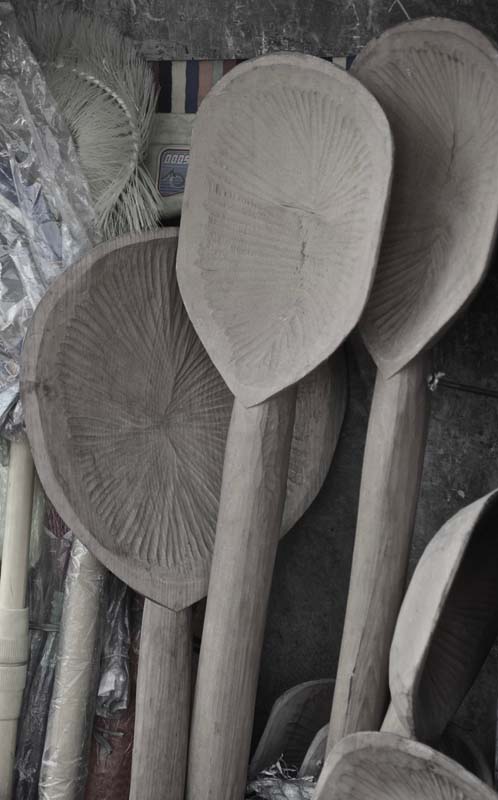
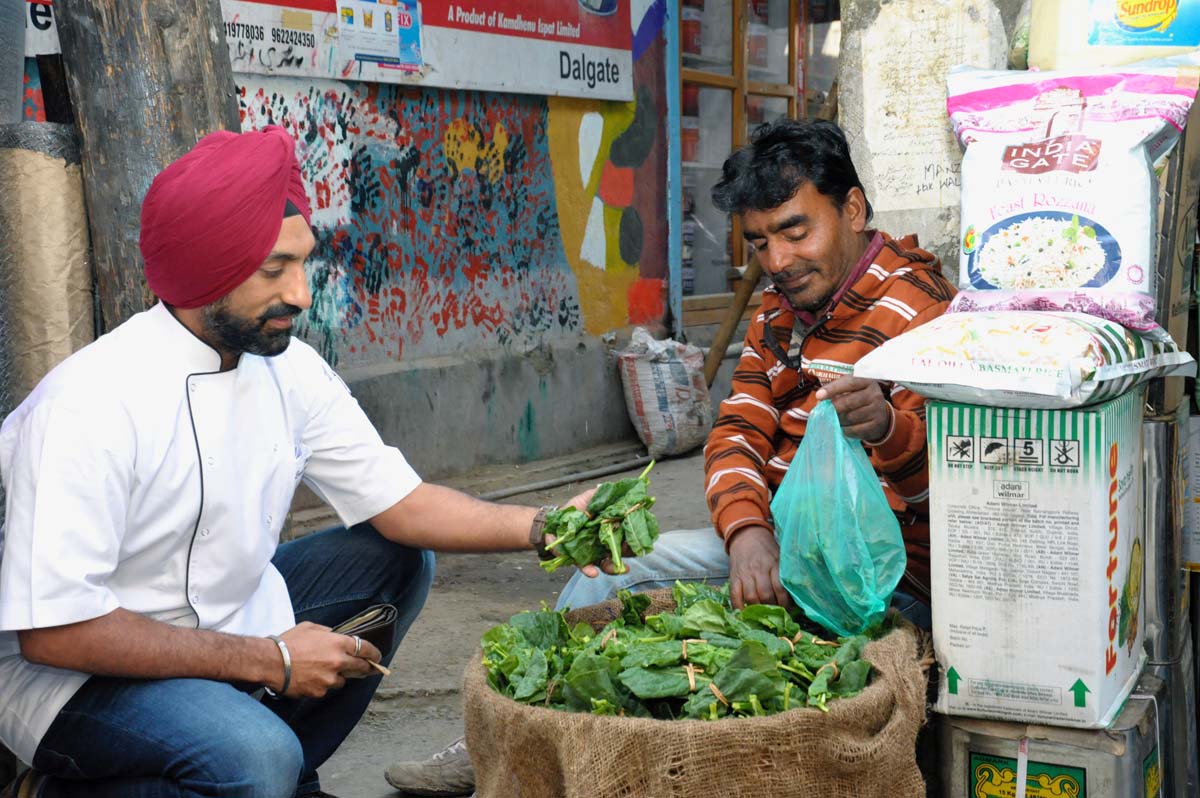
Dum Alu Kashmiri: A peeled and spiked baby potato, gently fried in mustard oil until totally tender and then further simmered in a yogurt based yakhani sauce. It is finished with Kashmiri red chili and praan and the potatoes should soak in all the goodness of the sauce.
Al Yakhani: Bottle gourd dish made by shallow frying small pieces in mustard oil before letting it simmer in the yakhani sauce. To finish, add praan paste and a spoon of hot mustard oil.
Potato chops: Bread crumbed potato patties stuffed with a minced lamb and boiled egg mixture and shallow fried. They are served with house dips, which can be tangy or spicy. As a note, tomatoes are generally not used in Kashmiri food.
Lavaash: Like a thin naan.
Aabeej: Made from sour green saag cooked with eggs bhurjee or kedgeree.
Mawal: Remove and discard the stem and only use the dried leaf in a powdered form. It is not water soluble but in oil medium.
Haak: The local greens that should be cooked as with saag greens – stirred or mashed and tempered.
Kashmiri Pulao: Another alternative method to make this brown rice is to caramelize the onion to prepare a base for the pulao and then adding stock to and steaming the rice in it. Boiled meat can be added in if you wish to.
Dhaniwal Khorma: To prepare this, start by blanching the lamb cuts and then getting rid of the scum. Boil the cleaned blanched lamb in a new batch of stock till it is tender. In a separate pan, lightly roast both praan and garlic until golden, then add a little stock to bring it to lower temperature. Then, add yoghurt and whisk till it reduces. Finish by adding the cooked lamb, along with fresh coriander, spices and blanched almonds (optional).
Hing: asafoetida tempering is done for Dum Alu in the end before service. (it is a Hindu Kashmiri dish)
Dodal: Vegetarian dish made with pumpkin. Peel, deseed and chop into wedges before boiling and cooking with cumin and yogurt as a base.
“Toor” Rista: Larger meatballs in Rishta
Shimla Mirch: A type of red chili used for its red colour Here it isn’t being referred to as a capsicum variety but a thicker version of dried red chilies.
Karadhi: A mature cheese made from buffalo milk. Often pan-fried and can be served for breakfast. Sheep milk products are used by the “Gujjars”, shepherds from the highlands in Kashmir.
Marchari: Local Kashmiri mirch. Other chili varieties available here include Patna, Shimla, and Punjab.
